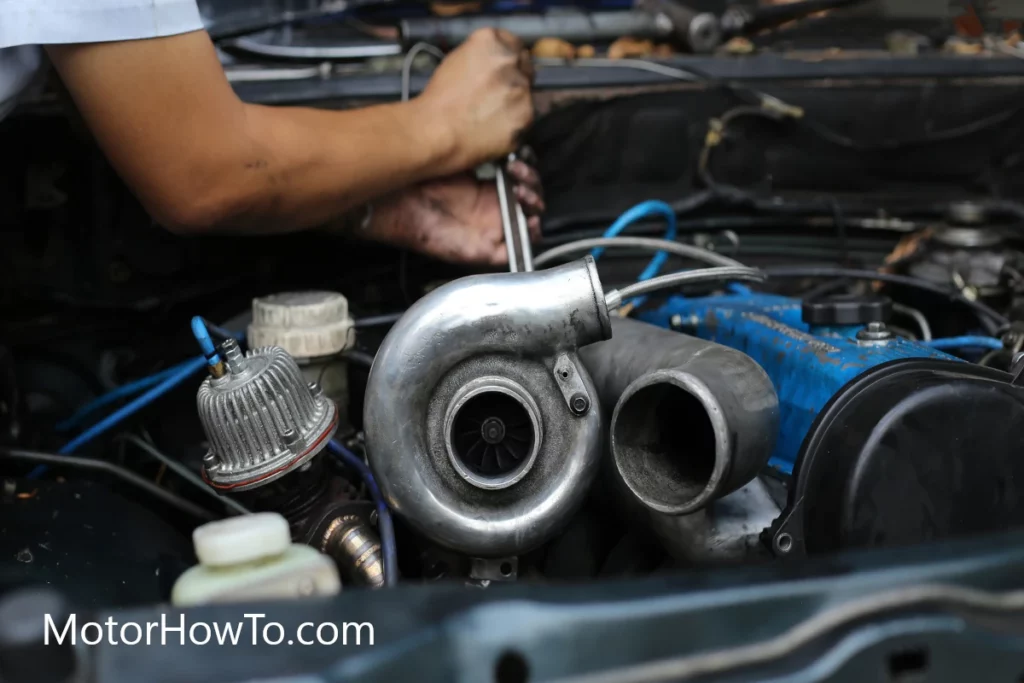There’s no shortage of heated debate and brand loyalty in high-performance turbochargers. As enthusiasts dissect different models’ minute specifications, efficacy, and overall prowess, two heavyweights emerge from the pack, consistently sparking spirited conversations.
The Fleece Cheetah and Stealth 64 are both formidable turbochargers, each with merits. The Cheetah excels in rapid spooling and responsiveness, while the Stealth 64 shines in durability and broader power range. However, the best choice depends on specific application needs and user preferences.

Drawing from the depths of engineering prowess and performance aspiration, this article dives deep into the specifics of two particular marvels, comparing and contrasting their capabilities, design, and real-world implications.
Buckle up as we delve into an intricate face-off between two turbocharger titans, leaving no stone unturned.
Related:
- Colorado Wheels on Silverado (Styling and Performance)
- How to Reset Exhaust Fluid Quality Poor? (Solved)
- Gravity Feed Fuel Tank Problems (Solved)
Introduction to Turbochargers
Turbochargers, often called “turbos,” are a marvel of automotive engineering designed to boost an engine’s efficiency and power output. At their core, these devices harness the power of exhaust gases, redirecting this otherwise wasted energy to spin a turbine.
As this turbine spins, it drives an air compressor that forces more air into the combustion chamber, allowing the engine to burn more fuel per cycle. The result? Enhanced horsepower and torque, transforming an average engine into a high-performance machine.
Despite their performance-enhancing attributes, the concept behind turbochargers is rooted in efficiency. Originally developed in the early 20th century, turbochargers were first utilized to compensate for reduced air pressure in aircraft engines at high altitudes. It wasn’t until the 1970s, with the global oil crisis and the subsequent push for fuel efficiency, that turbos began to find their way into everyday passenger vehicles.
Today, with the modern emphasis on performance and efficiency, turbochargers have become a staple in various vehicles, from economy cars to high-powered sports models.
Design Philosophy: Aesthetics and Engineering
Regarding the design of turbochargers, two crucial elements converge aesthetics and engineering. On the one hand, engineering dictates the functional aspects of the turbo, ensuring optimum airflow, reduced lag, and maximum power conversion.
Every curve, every angle, and every material used is meticulously chosen based on thermodynamics, fluid dynamics, and mechanical strength. The goal is clear: harness the maximum energy from the exhaust gases to amplify the engine’s power output.
Conversely, aesthetics plays a subtler yet equally vital role. In a world where car enthusiasts value not just performance but also the visual appeal of their machinery, a turbocharger’s design can make it stand out. A well-crafted turbo isn’t just an engine component; it’s a piece of art.
Manufacturers often go the extra mile to ensure their products have a distinct look, with polished finishes, branding, and unique design elements that make them instantly recognizable. This fusion of form and function epitomizes the modern approach to automotive components, proving that performance and beauty aren’t mutually exclusive but can coexist harmoniously.
Performance Metrics: What the Numbers Say
In the world of turbochargers, raw numbers often paint a vivid picture. They serve as an objective lens through which the capabilities of different models can be evaluated and compared. The most crucial turbocharger metrics are boost pressure, airflow rates, spooling times, and efficiency ratios.
- Boost Pressure: Measured in pounds per square inch (psi), this metric indicates the additional air pressure that a turbocharger introduces into the combustion chamber compared to atmospheric pressure. A higher boost generally means more power, but it also requires the engine components to withstand greater stresses
- Airflow Rates: Represented in cubic feet per minute (CFM), this metric quantifies the volume of air that a turbocharger can supply to the engine. Higher airflow rates are essential for larger engines or those aiming for substantial power gains.
- Spooling Times: This reflects how quickly a turbocharger can reach its optimal operating speed from a stationary state. Faster spooling times can lead to better throttle response and less noticeable “turbo lag.”
- Efficiency Ratios: This metric offers insight into how effectively a turbo uses exhaust gases to produce a boost. An efficient turbo will generate the desired boost pressure using less exhaust energy, leading to better fuel economy and reduced strain on the engine.
- Temperature and Heat Dissipation: Turbos can generate significant heat. The capability of a turbocharger to manage and dissipate this heat affects its performance and longevity.
By breaking down and comparing these performance metrics, enthusiasts and professionals can better understand a turbocharger’s real-world implications. The numbers don’t just quantify performance; they tell a story of engineering prowess, innovation, and the relentless pursuit of automotive excellence.
Spooling and Responsiveness: A Critical Comparison
The realm of turbochargers is rife with terms that pique the interest of automotive enthusiasts, and among the most discussed are “spooling” and “responsiveness.” These factors significantly influence a driver’s experience, especially in scenarios demanding quick acceleration or dynamic power adjustments.
Spooling refers to the time the turbocharger’s turbine takes to reach its operational speed when the throttle is applied. Essentially, it’s the time lag between the driver pressing the gas pedal and the turbo delivering its full power boost. A shorter spooling time is preferable, as it ensures that the power boost is delivered rapidly, translating to an immediate feel of acceleration.
On the other hand, responsiveness is a broader term that encompasses how quickly and efficiently a turbocharger reacts to engine demand changes. It’s about reaching peak power and how the turbo behaves during transitional phases, such as when varying the throttle during overtaking maneuvers or navigating winding roads. A highly responsive turbo offers smoother transitions, eliminating noticeable drops or surges in power.
The balance between spooling and responsiveness is delicate. While rapid spooling times are desirable, they shouldn’t come at the expense of overall responsiveness throughout the RPM range. A turbo that spools quickly but struggles to maintain consistent power during dynamic driving conditions would be less favorable than one that offers a holistic, well-rounded performance.
When comparing turbochargers like the Fleece Cheetah and Stealth 64, it’s essential to gauge how each fare in both these domains. The perfect turbo strikes a balance, offering swift spooling times while ensuring seamless power delivery in varying driving scenarios.
Durability and Lifespan: Which Lasts Longer?
At the heart of automotive performance lies a foundational concern: durability. While turbochargers can significantly enhance an engine’s capabilities, their efficacy over time becomes a paramount concern for manufacturers and users. After all, a turbocharger’s performance benefits mean little if it fails prematurely or requires frequent maintenance.
- Materials and Construction: The lifespan of a turbocharger begins with its core materials and construction methods. High-quality materials resistant to extreme temperatures and wear, like nickel-based alloys, titanium, and ceramics, form the backbone of a robust turbo. Manufacturing precision, weld quality, and balanced rotating assemblies are equally vital to ensure longevity and minimize vibrations that can lead to premature wear.
- Operational Stresses: Turbochargers operate under significant thermal and mechanical stresses. The rapid spinning of the turbine, often exceeding 100,000 RPM, coupled with the extreme heat of exhaust gases, can wear down components over time. Effective cooling systems, oil lubrication, and thermal barriers play pivotal roles in safeguarding the turbo’s longevity.
- Maintenance and Care: The lifespan of a turbocharger isn’t solely determined by its design and manufacturing. Regular maintenance, including timely oil changes, ensuring clean oil and air supply, and letting the engine warm up before hard acceleration, can dramatically extend a turbo’s operational life.
- Design Evolution: As technology evolves, so do turbocharger designs. Manufacturers continually seek innovations to enhance durability, from improved bearing systems to more efficient cooling mechanisms.
When contrasting turbochargers like the Fleece Cheetah and Stealth 64, it’s crucial to consider their immediate performance and resilience over time. While some models may boast exceptional short-term gains, a discerning enthusiast should weigh these against the potential long-term reliability and associated maintenance or replacement costs. The true mark of a superior turbocharger is one that delivers both power and persistence.
Efficiency and Fuel Consumption Analysis
Beyond the sheer power and exhilaration that turbochargers offer, there’s a more nuanced aspect: efficiency and fuel consumption. After all, a powerful engine that guzzles fuel excessively can quickly overshadow its performance advantages with increased operating costs and environmental concerns. Let’s delve into how turbochargers impact these critical areas.
- Turbocharging and Engine Efficiency: A turbocharger’s primary function is to force more air into the combustion chamber. This allows for a better air-fuel mixture, leading to more complete combustion. As a result, the engine can extract more energy from the same amount of fuel, enhancing its overall efficiency.
- Fuel Consumption Dynamics: A common misconception is that turbocharged engines always consume more fuel. A well-tuned turbocharged engine can be more fuel-efficient than its naturally aspirated counterpart under specific conditions. However, aggressive driving, where the turbo is constantly engaged, can lead to higher fuel consumption.
- Optimal Operating Range: Turbochargers are most efficient within a specific RPM range. Operating the engine within this “sweet spot” can optimize performance and fuel efficiency. Conversely, frequently pushing the engine beyond this range can decrease efficiency and increase fuel consumption.
- Engine Downsizing and Turbocharging: One of the modern automotive trends is engine downsizing, where manufacturers use smaller displacement engines coupled with turbochargers. This approach offers the same or even better performance than larger engines while consuming less fuel and producing fewer emissions, especially during low-load conditions like highway cruising.
- Innovations in Turbo Design: Modern turbochargers often incorporate features like variable geometry turbines (VGT) or twin-scroll designs. These innovations aim to optimize efficiency across a broader RPM range, ensuring that the turbo operates efficiently in varied driving conditions.
When comparing models like the Fleece Cheetah and Stealth 64, evaluating their impact on fuel consumption in real-world scenarios is essential. The ultimate goal is to balance exhilarating performance and economical, sustainable operation. After all, the pinnacle of automotive engineering lies in harnessing maximum power without sacrificing efficiency.
Closing Thoughts
In closing, the face-off between the Fleece Cheetah and Stealth 64 turbochargers has taken us on a fascinating journey into the intricate world of high-performance automotive components.
These turbocharger titans embody the spirit of relentless pursuit, engineering excellence, and innovation that drives the automotive industry forward.
Turbochargers, at their core, represent the perfect union of form and function. They are meticulously designed pieces of art that harness the wasted energy of exhaust gases to transform an ordinary engine into an extraordinary powerhouse.
In a world where aesthetics and performance coexist, turbochargers prove that beauty and functionality can harmoniously coalesce.
Performance metrics serve as our objective lens, quantifying the capabilities of these turbochargers. Numbers like boost pressure, airflow rates, spooling times, and efficiency ratios tell the story of engineering prowess and innovation.
These metrics become the basis upon which enthusiasts and professionals alike can evaluate and compare turbochargers’ real-world implications.
Spooling and responsiveness, often discussed passionately among automotive enthusiasts, are critical factors that shape the driving experience. The perfect turbocharger strikes a balance between swift spooling and seamless power delivery, ensuring a thrilling yet controlled drive.
Durability and longevity, fundamental concerns in the world of high-performance, highlight the importance of quality materials, precision manufacturing, and diligent maintenance.
The true mark of a superior turbocharger is one that not only delivers remarkable power but does so consistently over time.
Efficiency and fuel consumption, often overshadowed by raw power, represent the nuanced aspect of turbocharging. A well-tuned turbocharger can enhance engine efficiency, potentially improving fuel economy.
However, the ultimate goal is to strike a balance between exhilarating performance and sustainable operation, making modern turbocharged engines more efficient and eco-friendly.
In this detailed turbocharger face-off, we’ve explored the intricacies of two formidable contenders, leaving no stone unturned. The choice between the Fleece Cheetah and Stealth 64 depends on specific application needs and user preferences, emphasizing the importance of understanding the nuanced differences between these high-performance marvels.
As the automotive industry continues to evolve, turbochargers remain at the forefront of innovation, pushing the boundaries of what’s possible.
Their journey is a testament to the relentless pursuit of engineering excellence, where the quest for more power is matched only by the pursuit of greater efficiency, durability, and performance on the road.
In the world of turbochargers, the journey is far from over. It’s a thrilling ride, where art meets engineering, and numbers tell a story of power, responsiveness, and efficiency. Buckle up, for the road ahead promises to be both exhilarating and efficient, setting new standards for automotive excellence.
Sources
https://www.duramaxdiesels.com/forum/threads/fleece-cheetah-vs-dt-stealth-64.67033/
https://www.duramaxforum.com/threads/dts-stealth-64-or-fpe-cheetah-63.654737/
https://www.cumminsforum.com/threads/turbo-question-stealth-64-vs-borg-warner-sxe.2300410/



